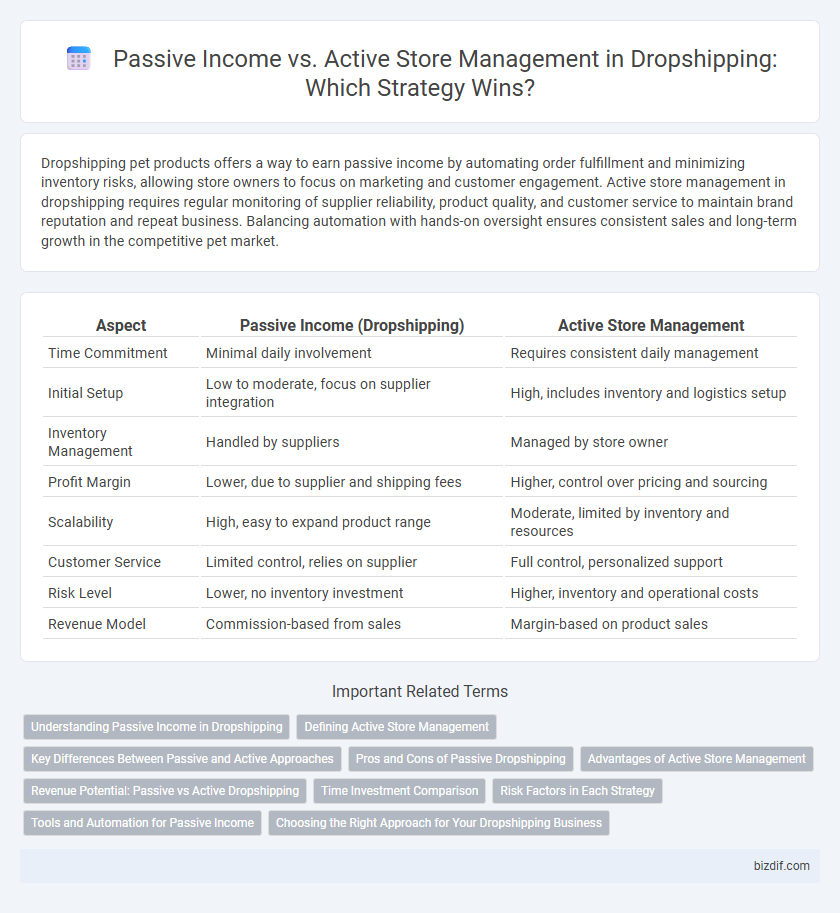Dropshipping pet products offers a way to earn passive income by automating order fulfillment and minimizing inventory risks, allowing store owners to focus on marketing and customer engagement. Active store management in dropshipping requires regular monitoring of supplier reliability, product quality, and customer service to maintain brand reputation and repeat business. Balancing automation with hands-on oversight ensures consistent sales and long-term growth in the competitive pet market.
Table of Comparison
| Aspect | Passive Income (Dropshipping) | Active Store Management |
|---|---|---|
| Time Commitment | Minimal daily involvement | Requires consistent daily management |
| Initial Setup | Low to moderate, focus on supplier integration | High, includes inventory and logistics setup |
| Inventory Management | Handled by suppliers | Managed by store owner |
| Profit Margin | Lower, due to supplier and shipping fees | Higher, control over pricing and sourcing |
| Scalability | High, easy to expand product range | Moderate, limited by inventory and resources |
| Customer Service | Limited control, relies on supplier | Full control, personalized support |
| Risk Level | Lower, no inventory investment | Higher, inventory and operational costs |
| Revenue Model | Commission-based from sales | Margin-based on product sales |
Understanding Passive Income in Dropshipping
Passive income in dropshipping involves automating product sourcing, order fulfillment, and customer service to minimize daily operational tasks. This model leverages tools like automated inventory updates and third-party logistics (3PL) providers, allowing entrepreneurs to generate revenue without constant store management. Understanding that true passive income requires upfront setup and ongoing optimization is crucial for sustainable profits.
Defining Active Store Management
Active store management in dropshipping involves continuous oversight and hands-on tasks such as inventory tracking, customer service, order fulfillment, and marketing optimization to maintain smooth operations. Unlike passive income models, it requires consistent time investment and prompt problem-solving to adapt to market changes and ensure customer satisfaction. Effective active management directly impacts store performance, sales growth, and brand reputation.
Key Differences Between Passive and Active Approaches
Passive income in dropshipping relies on automated processes and minimal daily involvement, often utilizing tools like automated order fulfillment and marketing campaigns to generate revenue. Active store management demands continuous attention to customer service, inventory updates, and real-time marketing adjustments to optimize sales performance. Key differences include the time commitment, with passive approaches focusing on system optimization, while active management requires hands-on interaction and frequent strategic decision-making.
Pros and Cons of Passive Dropshipping
Passive dropshipping offers the advantage of low upfront investment and minimal hands-on management, making it ideal for entrepreneurs seeking semi-automated income streams. However, the lack of direct control over inventory and customer service can lead to slower response times and potential quality issues, impacting brand reputation. While passive dropshipping generates revenue with limited daily involvement, it may sacrifice scalability and customization compared to active store management.
Advantages of Active Store Management
Active store management in dropshipping enables real-time inventory control and personalized customer service, which significantly reduces order errors and increases customer satisfaction. This hands-on approach allows for quick adaptation to market trends and competitor strategies, driving higher sales and growth opportunities. Actively managing a store also provides detailed performance insights, facilitating strategic decision-making and continuous optimization of marketing campaigns.
Revenue Potential: Passive vs Active Dropshipping
Passive dropshipping offers limited revenue potential as profits largely depend on automated systems with minimal intervention, often resulting in slower growth. Active store management enables higher revenue generation through constant product optimization, marketing strategies, and customer engagement, directly influencing sales volume and profit margins. Data from industry reports indicate active dropshipping stores can achieve up to 3 times greater monthly revenue compared to passive models.
Time Investment Comparison
Passive income in dropshipping requires minimal daily involvement, allowing entrepreneurs to automate order processing, customer service, and inventory management with efficient tools. Active store management demands significant time investment for tasks like product research, marketing campaigns, and real-time customer engagement to optimize sales and growth. Time allocation in dropshipping varies widely; passive models emphasize automation and systematization, while active management relies on continuous hands-on effort for competitive advantage.
Risk Factors in Each Strategy
Passive income through dropshipping often involves lower upfront investment but carries risks such as supplier reliability issues and limited control over product quality. Active store management demands continuous engagement in inventory oversight, customer service, and marketing, increasing operational risks but allowing greater control over brand reputation and customer satisfaction. Understanding these risk factors helps entrepreneurs balance effort and potential returns effectively in dropshipping ventures.
Tools and Automation for Passive Income
Leveraging automation tools such as Oberlo, AutoDS, and Shopify apps streamlines inventory management, order fulfillment, and customer communication to enable passive income in dropshipping. Integrating AI-driven chatbots and automated marketing platforms reduces the need for constant manual oversight, allowing store owners to focus on scaling rather than daily operations. Utilizing real-time analytics and automated pricing tools optimizes profit margins while minimizing active store management efforts.
Choosing the Right Approach for Your Dropshipping Business
Selecting the right approach for your dropshipping business hinges on balancing passive income goals with active store management demands. Passive income strategies often involve automating order fulfillment and customer service, reducing daily involvement but requiring upfront investment in reliable tools and supplier partnerships. Active store management allows for real-time optimization of product listings, marketing campaigns, and customer interactions, potentially increasing revenue but demanding consistent time and effort.
Passive Income vs Active Store Management Infographic

 bizdif.com
bizdif.com